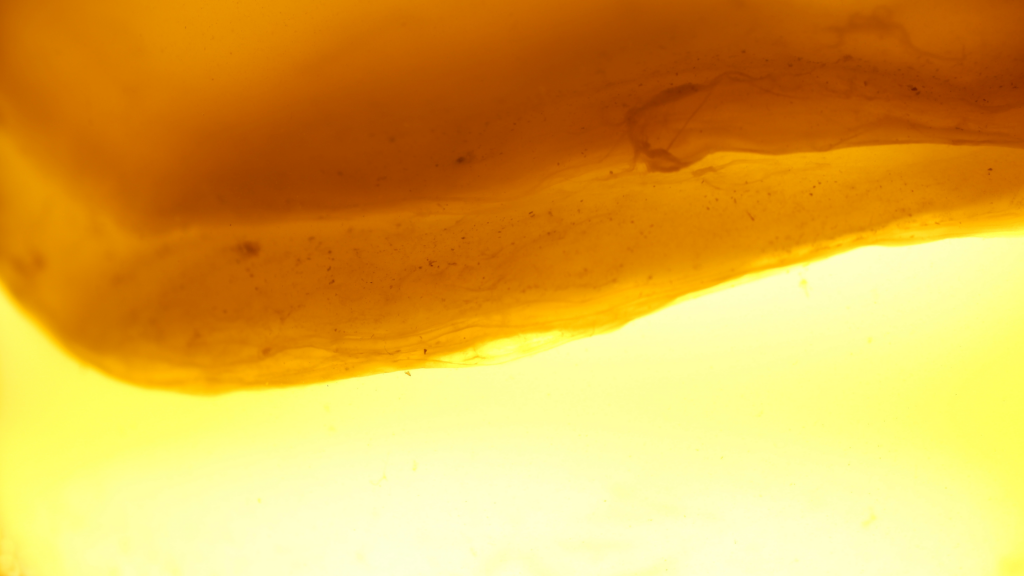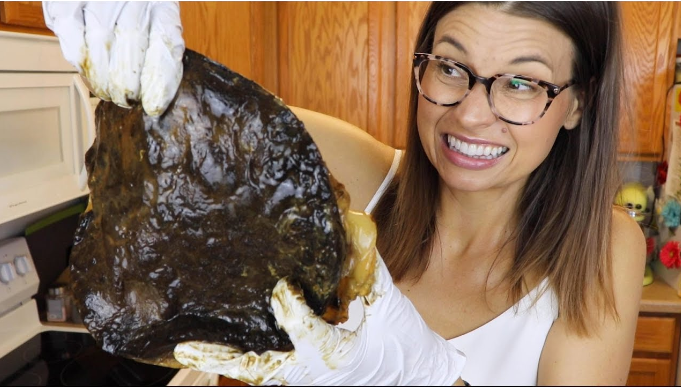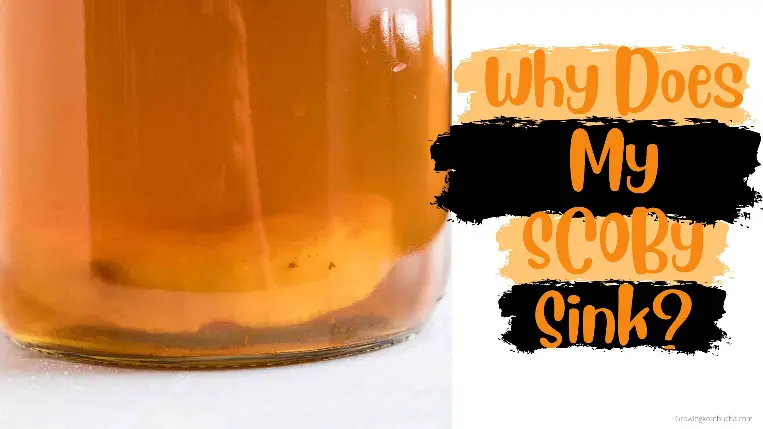In this post, we’ll explore why your SCOBY is sinking and what it means.
Kombucha is a delicate drink to prepare, which makes brewers wary of anything that may compromise its safety and flavor. Sure enough, no one wants to wait for two weeks of fermentation only to find out that the SCOBY spoiled the whole batch.
Is it normal for SCOBY to sink?
Ironically, it is normal for SCOBY to sink. Though a floating SCOBY signifies a healthy brew, it is not the basis of the health of the whole batch. The weird-looking blob can go anywhere it wants inside the kombucha jar and still produces the best-tasting kombucha. However, there are a few caveats when a SCOBY has not submerged well in the brew.
Q: Why does my SCOBY sink?
The easiest way to understand why SCOBY sinks is to know how kombucha ferments. Firstly, the healthy bacteria and yeast in SCOBY release carbon dioxide as they convert sugar into acid and alcohol.
When the bacteria in SCOBYs actively ferment the kombucha, the carbon dioxide released causes the SCOBY to be pushed up, allowing it to float within the brew. When a SCOBY sinks, it can either be due to any of the following reasons:
1. Low temperature
The temperature and age of a SCOBY determine its performance in fermenting sweet tea. The ideal brewing temperature of kombucha is 75 F to 80 F, which gives bacteria and yeast the optimal condition to ferment the brew. High temperatures make them overactive and low temperatures make them sluggish and dormant.
If a floating SCOBY suddenly sinks, it is probably due to the drop in temperature. With a sluggish SCOBY, there will be less sugar conversion and carbon dioxide release.
Without enough carbon dioxide, the SCOBY will remain at the bottom of the brew. You can check the kombucha’s temperature by using a temperature strip. If the temperature drops below 75 F, you may use a kombucha heating pad to achieve the optimal brewing temp.
Prolonged exposure to kombucha at low temperatures delays the production of acids and increases the risk of kombucha in developing molds.
2. Density
Another reason why your SCOBY sinks is because of the density variance within fermented teas. In a 3-gallon kombucha, SCOBY is denser than the weight of the liquid.
The best example of density is how steel sinks while wood floats in big bodies of water. Humans submerge in water because our muscles are denser than water. We can float in water due to the fat and air in our bodies. When all of the air is released, we will sink. Likewise, a SCOBY is chunky and denser than sweet tea, which causes it to submerge in the jar.
3. Bacteria population
During the fermentation, the activity of the good bacteria and yeast in the SCOBY can cause imbalances in their population. One side of the SCOBY might encounter a spike in active bacteria, while the other side is sleepy, sluggish, or old. This behavior might cause the active site of the SCOBY to float while the other sinks, causing it to move to the surface in a diagonal position.
Brewers often reuse SCOBYs to ferment new brews. However, like other organisms, they age and become weaker over time. The initial indication of an old SCOBY is when the tea fails to taste sour after a few days.

Why it is best to keep the SCOBY submerged in the tea
A submerged SCOBY does more good than harm for your kombucha. Though it may indicate some underlying factors like low temperature, its position under the tea is a low-key defense mechanism. Here are the reasons why:
- Mold prevention: Mold growth is the enemy of every kombucha brewer. Molds can spoil a batch because they make it dangerous to drink. They may form on air-exposed SCOBY at the surface of your brew.
Kombucha contains acids that kill contaminants. Brewers are wary of pathogens during the first fermentation because the SCOBY is still converting acids. As more acid develops in the brew, there’s a lesser chance of contamination.
The acids on the tea keep the SCOBY free from any mold growth. A sinking SCOBY means it is safe under the blanket of acidic sweet tea.
- Increase carbonation: A submerged SCOBY traps the carbon dioxide in the tea until it finds a way out from the surface of the brew. The second fermentation will trap the CO2 and make the booch fizzy or carbonated.
Signs of an unhealthy kombucha
While a sinking SCOBY does not indicate an unhealthy kombucha, some signs will tell you when to toss the batch in the drain. These include:

- Black SCOBY: Black SCOBY is a sign that it is already dead and decomposing. SCOBYs have streaks of brown pigment due to the tea. If the dark spots become prominent and the smell is horrible, you should toss the brew to the drain.
- White and feathery molds: when the SCOBY protrudes on the surface of the tea, it can develop white and feathery molds. The presence of these molds means that the batch is already contaminated and no longer safe to drink.
- Gray or green molds: Unsupervised kombucha often develops unusual strains of molds that cause gray or green molds. These are common issues for brews that experience fluctuating temperatures.
- No carbonation or lack of sour taste: When a brew is still sweet after a week or two, it means your SCOBY is already weak, or the temperature is too low. It indicates that the yeast and bacteria are sluggish, which increases the risk of your brew contamination.
Frequently Asked Questions (FAQs)
Does new SCOBY grow on top or bottom?
Usually, a new layer of SCOBY grows on top of the brew. When you notice that the surface looks disturbed, it is an indication that a thin layer of SCOBY is already developing.
How thick should SCOBY be?
Ideally, the SCOBY should be ¼ inch. It is too chunky when its thickness reaches an inch. The texture should be cloudy and has a lot of bubble marks. In some cases, the SCOBY can also be translucent.
Can you cut your SCOBY in half?
Yes, it is safe to cut a SCOBY in half. Though it looks like jelly, SCOBY is tough and fibrous. So, it is best to use a pair of scissors. Ensure that the tools you use are sanitized with alcohol or vinegar to avoid contamination.
